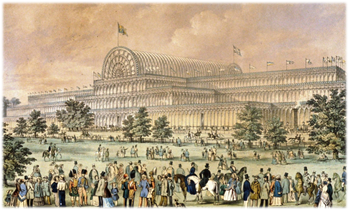By local resident and contributor John Taylor
Prince Albert, together with Henry Cole a member of the Society of Arts, approached the government in 1850, with the idea for the exhibition. A Royal Commission was established to investigate, and initial doubts from the authorities were soon replaced by enthusiasm. A self-financing event, The Great Exhibition, took place in Hyde Park, London from the 1st of May to the 15th October 1851.It was the first in a series of World’s Fairs that became popular in the 19th century. Queen Victoria and Prince Albert conducted the first ever royal walkabout on the opening day. The prime motive for the event was to show that Britain was the world’s industrial leader. Europe had just struggled through an era of political and social upheaval and now Britain wanted to show that technology was the route to a better future.
The Crystal Palace was built to house the show. It took the form of a massive glass house, 563 metres long by 124 metres wide. Constructed from cast iron frame components and glass, and designed by Joseph Paxton. The interiors enormous size was emphasized with trees and statues. Large trophy exhibits were shown in the Central Avenue, generally art or raw materials, also printing machines, folding pianos, ceramics, kitchen appliances, tinned foods, a stuffed elephant, and steel making displays, together with steam engines, railway locomotives, and early versions of bicycles. Visitors could also watch the entire process of cotton production from spinning to finished cloth. Scientific instruments, including electric telegraphs, telescopes, microscopes, musical and surgical instruments could be seen. There were over 13km of display tables.
The western half of the building showed exhibits from Great Britain, whilst the eastern half was filled with displays from other parts of the world. The Koh-i-Noor diamond, meaning the ’Mountain of Light’, was the world’s largest known, and it was one of the most popular attractions of the Indian exhibits. Canada sent a fire engine with painted panels, showing Canadian scenes. The American display was headed by a massive eagle, and France exhibited sumptuous tapestries. From Russia, huge vases and urns, and from Switzerland gold watches. Chile showed a single lump of gold weighing 50kg. There were over six million visitors, and from the 24th May one shilling entry tickets were available. Guests were catered for with refreshment courts and the novel public lavatories which cost a penny to use. Among visiting celebrities of the day were Charles Darwin, Karl Marx, Charlotte Bronte, Charles Dickens, Lewis Carroll, George Eliot, and Alfred Tennyson.
The event made a surplus of £186.000 which was used to establish The Victoria and Albert, The Science, and The Natural History Museums. The great spectacle proved to be successful, and became one of the defining moments of the nineteenth century. A memorial to the exhibition, is located behind The Royal Albert Hall.
Following the closure of The Great Exhibition, The Crystal Palace building was taken down, and rebuilt at Sydenham Hill, London. Tragically on the 30th November 1936 the palace was destroyed by one of the greatest fires ever seen in the capital. The cause remains unknown. Thousands came to Sydenham Hill to watch the blaze, among them Winston Churchill, who declared ”This is the end of an age”.

